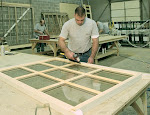
The use of restoration epoxies is pretty standard for a wood window restoration project. These two-part systems have become common tools of the trade over the past fifteen years. In the past ten years, several manufacturers have entered the business from mainstream brand names like Minwax to obscure names like Gougean Brothers. One thing is perfectly obvious, restoration epoxies have been a revolutionary development for preservationists.
The manufacturers of restoration epoxy do a decent job of providing directions on the use of their products, and what type of precautions one should take when mixing and applying the material. For example, West System has directions for using their products for various restoration projects. The following link displays many possibilities: http://www.westsystem.com/ss/use-guides/ Abatron has a very useful video on how to mix and apply their products to wood on the following link: http://www.youtube.com/watch?v=2yGQMnmNK1Y&feature=player_embedded
Unfortunately, the manufacturers provide only the basic information on how to safely apply their products and neglect to inform the purchaser on the finer points of product utilization. A great deal of the instructions focus on the CYA that is required when you sell a product that can have hazardous consequences if ingested or used improperly. There are a couple of critical problems that can occur with restoration epoxies that are neglected in the typical instruction manual.
The first problem is the importance of the moisture content of the wood that is being restored. Most restoration craftsmen don't take the time to test the moisture content of the restored wood. Since the wood elements must have their existing finishes removed prior to the application of the epoxy, sills, brickmould, frame members, and sash can often be exposed to the elements after all finishes are removed. They can absorb moisture during this period of exposure. The neutralization of strippers used to remove these finishes can also increase the moisture content of the wood. If the wood has a moisture content in excess of 12%, you can have future problems with the adhesion of the epoxy fillers. The last thing you need is to have
epoxy fillers cracking and buckling. We find that it is important to measure the moisture content of the wood substrate prior to application of the restoration epoxies. There are several moisture meters on the market that are excellent tools for this measurement. We advocate the use of a meter that facilitates moisture measurements below the surface of the substrate. You can have acceptable readings on the surface while the heart of the section of wood is reading 25% moisture content. We use moisture meters manufactured by Lignomat that have two tines that penetrate deeply into the wood. You can find more information on this product by following this link: http://www.lignomat.com/MoistureMeter/index.html
Another challenge we have found with restoration epoxies is the tendency to over apply the epoxy fillers to a wood member. You see this occur particularly on sill reconstruction on a wood window. Many sills that have been neglected for the past 50 years have lost much of their original profiles. If you use the restoration epoxy to completely rebuild the sill to the point where all exterior surfaces are encapsulated in 1/4" or more of the epoxy filler, you run the risk that you will encapsulate the entire wood substrate. Wood must be allowed to breathe. If it doesn't have adequate means to adjust its moisture content, it will either rot or cause the epoxy filler to lose its bond.
If used properly restoration epoxies are an economical and durable way to breathe new life into a historic wood window.






Hi there! this is such an informative post. Thank you for sharing. Cheers!
ReplyDelete- The historic wood window ma